Norman Rockwell didn’t create his celebrated images using only brush and paint. They often took shape first as scenes that Rockwell literally acted out, not only for his editors at the Post, but his real-life models, too. “It was strenuous,” he once explained, “but I felt it was the best way to get across my meaning.” And so he would enthusiastically play out his visions and ideas, a one-man show packed with just the right expressions, giving enough details of each persona in the scene to inspire his models and, more importantly, get his editors to buy his ideas.
Now, more than 30 years after his death, Rockwell is still acknowledged for deftly chronicling the best of 20th century American life with vignettes of simple emotions evoked by everyday people. This phenomenon is a resounding testament to Rockwell’s prowess as a storyteller and is the subject of another kind of one-man show: the upcoming exhibition at the Smithsonian American Art Museum in Washington, D.C., titled Telling Stories: Norman Rockwell from the Collections of George Lucas and Steven Spielberg. The exhibit, assembled from the private collections of these two popular film directors, will feature rarely viewed pieces of Rockwell’s work, including George Lucas’ favorite, Lands of Enchantment, which shows a youngster imagining himself as an armor-clad knight riding away with a beautiful girl. The point is not the boy reading, but how the book inspires the boy’s imagination, taking him, in idealized form, to another time and place.
“It’s a painting celebrating literature, the magic that happens when you read a story and the story comes alive for you,” notes Lucas.
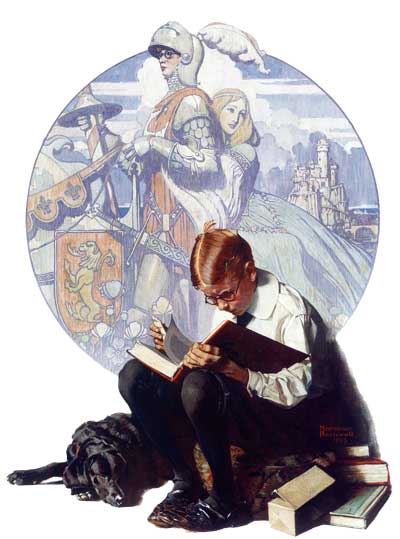
by Norman Rockwell
November 10, 1923
© SEPS.
And that’s just one of the 50-plus images from the highly anticipated exhibit, which runs from July 2, 2010 through January 2, 2011. The exhibit will also explore the artist’s elaborate creative process while spotlighting Rockwell’s ability to capture the range of human expression and distill whole episodes of American life into single and broadly accessible moments by drawing upon a full arsenal of skills that would have served him well as a filmmaker.
According to Virginia Mecklenburg, the museum’s senior curator, both Lucas and Spielberg were inspired by Rockwell’s creativity and tender subject matter, as well as his warm depictions of America without cynicism.
“Both filmmakers grew up in the 1950s, enjoying Rockwell’s illustrations on the cover of The Saturday Evening Post,” says Mecklenburg. “They share the artist’s sensibilities in many ways, and have sought to express similar values, such as loyalty, courage, and friendship, in their own work.”
When working on Star Wars, Lucas said that he realized there needed to be a kind of film that expresses those values, as well as the mythological realities of life—the deeper psychological movements of the way we conduct our lives—that are evident in fairy tales. “Once I got into Star Wars, it struck me that we had lost all that—a whole generation was growing up without fairy tales. You just don’t get them anymore, and that’s the best stuff in the world,” Lucas explains.
Like Lucas, Rockwell was an original. He grew up on the Upper West Side of Manhattan, living in a rough-and-tumble New York boarding house. He quit high school to attend classes at the Art Students League in New York, and was already a working, if occasionally struggling, artist in his teens. But in 1916, when he sold his first cover to the Post, he began to carve what would become a unique niche in the American psyche. Throughout the course of 323 Post covers over the next 50 years, he would stoke and affirm our pride in who and what we are at our very best moments, even if most of us rarely experienced the fresh-faced version of the world.
“Storytelling was very important to Norman Rockwell,” says Lucas. “Every image has either the middle or the end of a story, and you can already see the beginning even though it’s not there. You can see all the missing parts of the story because he took that one frame that sort of tells you everything you need to know.
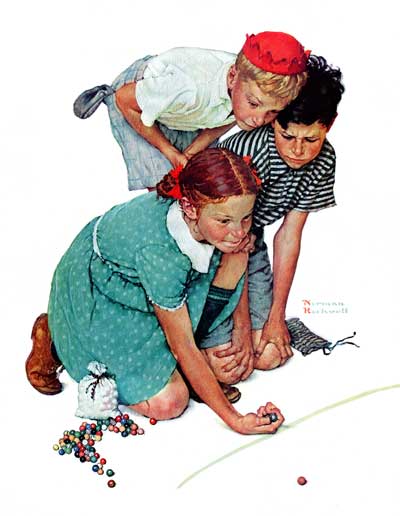
by Norman Rockwell
September 2, 1939
© 1939 SEPS.
“And, of course, in filmmaking we strive for that. We strive to get images that convey, visually, a lot of information without having to spend a lot of time at it. Norman Rockwell was a master at that—he was a master at telling a story in one frame,” explains Lucas.
That concentration of information as well as emotion is something inherent in Rockwell’s art. Emotion certainly spoke to Steven Spielberg when he first saw one of his favorite Rockwell paintings, High Dive, the August 16, 1947 Post cover that depicts a boy at the top of what must be (or so we imagine from the boy’s expression) a towering diving board. He crouches high above a swimming pool, too afraid to either jump or climb back down. The painting hangs in Spielberg’s office at Amblin Entertainment because it holds a great deal of meaning for the filmmaker.
“That painting spoke to me the second I saw it … and when I was able to buy it, I said, ‘Not only is that going in my collection, but it’s going in my office so I can look at it every day of my life.’ We are all on diving boards hundreds of times during our lives. Taking the plunge or pulling back from the abyss … it is something that we must face. For me, that painting represents every motion picture, just before I commit to directing it—that one moment before I say, ‘Yes, I am going to direct that movie,’ ” says Spielberg.
In the case of his Oscar-winning film Schindler’s List, Spielberg remarked, “I lived on that diving board for 11 years before I eventually took the plunge.”
Even in the creation of their work, Spielberg and Rockwell were more similar than is immediately evident. To create his meticulously detailed recollections of everyday American life, Rockwell worked much like a film director, not just acting out the scenes in his imagination, but scouting locations, casting everyday people from his town for particular parts, choosing costumes and props, and directing his performers to make them instantly familiar to the public. Little wonder then, that filmmakers like Spielberg and Lucas, as well as others, should be so inspired by his work.
In directing his own scenes, Rockwell had a specific focus, just not one based on the stark realism in which he grew up. Instead, Rockwell aimed to depict life in a kind of realistic fantasy. He later remarked in his autobiography, My Adventures as an Illustrator, “I paint the world not as it is, but as I would like it to be.”
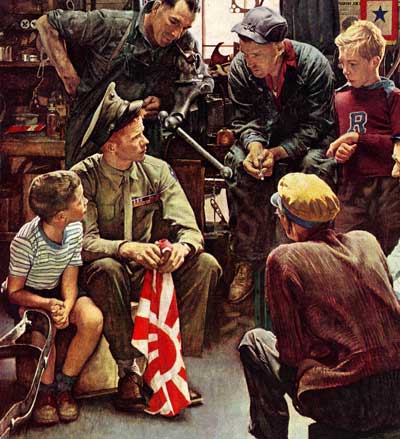
© SEPS
This desire to “make” the real world a better place, at least in his images, was a sentiment that Rockwell would voice throughout his life. Eventually, he sought something of the idealized world he imagined, when he moved out of the city, first to New Rochelle, New York, then later settling in Vermont with his family. Rockwell found new models in the form of neighbors, as well as his children.
“All of us, my brothers, my mother, and myself, as well as our friends, served as characters in my father’s illustrations at one time or another,” says his son Tom, himself a writer, perhaps best known for his popular children’s book, How to Eat Fried Worms.
A study of Rockwell’s creative process reveals that composing each of his simple-to-understand works wasn’t simply a matter of grabbing whoever was handy and drawing them into a picture. In fact, each image was a highly involved endeavor requiring masterful ability as an illustrator and painter, as well as his unique skill to create “scenes” that would be instantly understood by the viewer.
“Everything I have ever seen or done has gone into my pictures in one way or another. The story of my life is really the story of my pictures and how I made them,” Rockwell said. “I store up things in my mind, and when I need something for a picture—a feeling, a character, a wry smile—there it is. And I draw it out and paint it.”
In the act of describing his work, Rockwell, the artist, embodied his characters, just as his work now embodies aspects of the American character that still strikes a chord, inspiring both other artists and Americans from all walks of life today.
The fact that Rockwell’s canvases are populated with such real-looking people is likely what gives them such resonance, making them believable. Still, there is something in the facial expressions that Rockwell not only captures, but exaggerates—youthful enthusiasm, boyish eagerness, pride, yearning, determination, and more—that transcends location, time period, and situation and makes the works both easy to connect with and ripe for repeated rediscovery, generation after generation.
In this context, Rockwell becomes as significant as any American artist has ever been, and can arguably be credited not only with recounting the American experience but to a large extent, with constructing the collective “memory” of the good old days that we still yearn for, whether we ever personally experienced them or not.
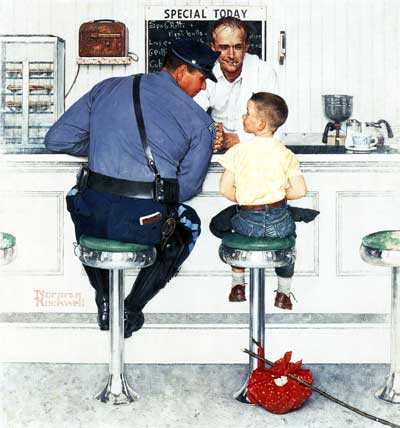
© SEPS.
Rockwell’s opinion of his work during his life was decidedly more humble, however. Certainly he was conscious of his role in the art world. He was an illustrator, not a modern artist or fine arts painter, and he had to satisfy not only himself, but his clients and audience alike. He needed to create scenes that people would get in a matter of seconds. He had to meet deadlines and stick to magazine proportions. And within those strict parameters, he wanted to convey this sense of idealized life. “I guess I had a bad case of the American nostalgia for the clean, simple country life, as opposed to the complicated world of a city,” he explained.
Rockwell’s insight and anything-but-easy process is itself the subject of a new, in-depth book, Norman Rockwell: Behind the Camera, by author and historian, Ron Schick.
“In order to ensure that every detail was perfect, Rockwell first used models and drew from life. Eventually, though, he switched to photographing his subjects in a variety of poses and with varying props, locations, and models. Every minute detail was deliberate, a means of convincing the viewer that they were eavesdropping,” says Schick, who describes Rockwell as a narrative artist with a Jeffersonian sense of America and its modest, everyday heroes.
“The world needed comfort, something to believe in, and Rockwell gave it to them in a way that people from all walks could understand,” Schick says. Understand, yes, but also be emboldened. The moments of inspiration that the artist captured, the tacit encouragement to move forward and celebrate life with all its challenges, setbacks, and triumphs—these ultimately may be Rockwell’s best legacy.
In a nation with cultures as disparate as ours, that Rockwell consistently managed to find patches of common ground for us to build on is a testament to his enduring work, not only for the generations of Americans who grew up seeing his art when it was new, but for future generations who are seeing Norman Rockwell’s America for the first time.
For more information, check out our Post retrospective Norman Rockwell and American Idealist Art.
Become a Saturday Evening Post member and enjoy unlimited access. Subscribe now
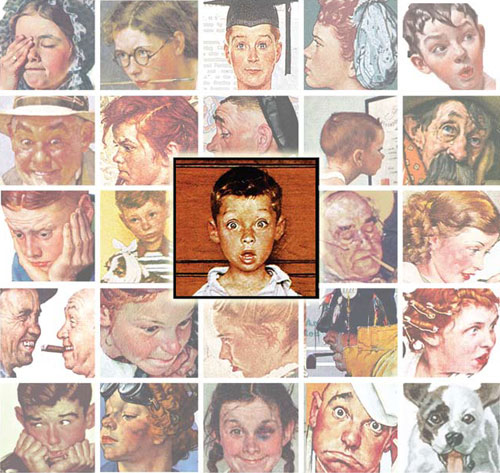
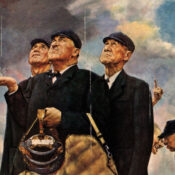


Comments
I have a Norman Rockwell Piece ,”The Street Will Never Be The Same”
This is a real life type scene, i hear he did this prior to painting, it is elevated, wonderful color,exactly like the picture, this was an ad he did for ford motor corp. in 1953.Chicago Historical society says he did a series for fords 50th anniversary. This was an ad for them.The picture was is on the back of the life like scene. is this worth money, it is in great condition?
noman rockwell loved people and it shows in his pictures.
Rockwell’s greatness obviously didn’t “just happen.” He, like so many other gifted artists, labored mightily at his love.